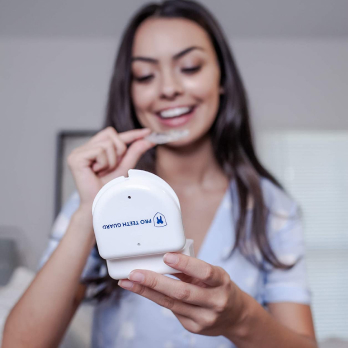TMJ After Braces
12th Mar 2022

Bite alignment is always a concern when people are fitted for orthodontic devices. After all, the goals of orthodontic treatment are a beautiful smile and a healthy bite. However, if you use a retainer after braces and struggle with temporomandibular joint disorder, you may feel confused as to how to treat the condition and straighten your teeth simultaneously. Fortunately, there are options to fix misaligned bite and protect your teeth and jaw from TMJ damage. While there are mixed options among experts on the relationship between TMJ after braces and bite misalignment, there are many noninvasive treatment options to treat TMJ and maintain your healthy smile.

Do Braces Cause TMJ Disorder?
Numerous studies have looked for a correlation or connection between orthodontic treatment and TMJ disorder. The results have been mixed, so experts have different opinions on the subject.
Some orthodontists believe that orthodontic treatment is a potential cause of TMJ pain. They point to the relationship between the jaw joint and a person's natural bite when making their argument.
Other experts think that any causal link between orthodontic treatment and TMJ disorder is weak. As Impressions Orthodontics explains, not all bad bites cause TMJ dysfunction. In fact, out of the various types of malocclusions, only anterior open bites and posterior crossbites are consistently linked with a higher prevalence of joint problems. People with other “bad bites” don't report TMJ pain in statistically significant numbers. However, many people with perfect bites do, leading experts to believe the correlation between TMJ and misaligned bites is weak.
What causes TMJ disorder? As Johns Hopkins Medicine explains, the causes aren't always clear. The list of potential culprits includes trauma, bruxism, arthritis, fibromyalgia, and displacement of the jaw joint discs. Researchers can't always pinpoint the exact cause of someone's TMJ disorder. However, they have identified a list of clinical, genetic, sensory, psychological, and nervous system factors that may increase your odds of developing TMJ issues.

How is TMJ After Braces Treated?
Today's orthodontic treatments take many forms. Traditional metal braces, ceramic braces, clear tray aligners like Invisalign, and retainers are among some of the popular options. Fortunately, if you've developed a TMJ disorder after having braces or some other orthodontic treatment, there are a variety of treatments that could help with your TMJ problems. MedicineNet offers some ideas:
- Mouthguards, night guards, or oral splints are among the most common treatment options for TMJ and bruxism. These custom-fitted appliances should be fitted by a specialist. They may be worn during the day and/or overnight.
- TMJ exercises may be recommended to stretch sore jaw muscles. These simple movements can be performed at home once or twice a day. In more severe cases, you may be advised to visit a physical therapy center. In this situation, TENS for TMJ therapy, biofeedback, or professional massage may be provided by a physical therapist.
- Medications may provide relief from pain, inflammation, or tension. Muscle relaxants, corticosteroids, over-the-counter anti-inflammatories, and pain killers are all treatment options.
- Botox injections are sometimes used to weaken the masseter muscles. Doing so limits teeth grinding and jaw clenching, reducing the stress on the jaw joints.
- Acupuncture uses hair-thin needs placed in acupoints to lessen pain and inflammation. Some people find it eases TMJ pain.
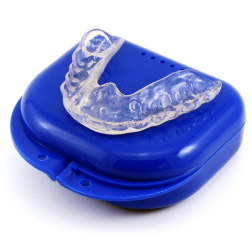
- Most Popular
- Hard Outside, Soft Inside
- 2MM Thick
- Moderate / Heavy
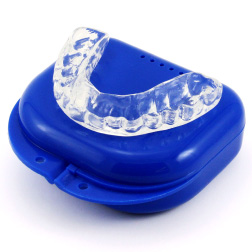
- Most Durable
- Hard Materials
- 1.5MM Thick
- Heavy / Severe
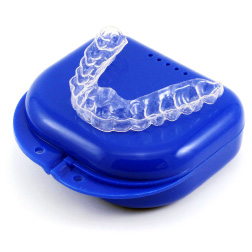
- For Day Time Use
- Thin, Barely Visible
- 1MM Thick
- Light / Moderate
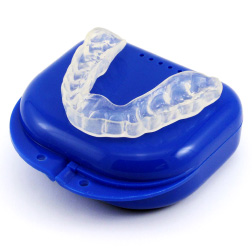
- For Clenching
- Flexible & Soft
- 1.5MM Thick
- Light / Moderate
Related Articles:
What are the Symptoms of TMJ Disorder?
The TMJs are hardworking joints. They connect the mandible, or lower jaw, to the skull. That means that they're involved every time you speak, chew, or do anything that involves opening and closing your mouth. With their active role, it makes perfect sense that any TMJ dysfunction could trigger a wide range of symptoms. Cleveland Clinic offers an extensive list:
- Jaw pain
- Jaw joints that lock
- Trouble opening the mouth fully
- Jaw popping or clicking
- Difficulty chewing
- Bruxing, teeth grinding, and jaw clenching
- Bite changes
- Toothaches
- Pain or fatigue in the facial muscles
- Swelling of the face or jaw
- Earache
- Tinnitus
- Headaches
- Pain in the neck or shoulders
TMJ After Braces: Causes and Treatment
While there is no widely accepted consensus on the causal relationship between braces and TMJ, one thing is clear: More research is necessary. In the meantime, if you are battling temporomandibular joint disorder, explore treatment options with your doctor or dentist. Proper treatment can help alleviate pain and prevent damage to the teeth and jaw. Visit your doctor or dentist to discuss your symptoms, and have X-rays taken so that you can get the right diagnosis and treatment.
References:
- Cleveland Clinic Writing Staff. (2021). Temporomandibular Joint (TMJ) disorders: Symptoms, treatment & prevention. Cleveland Clinic. Retrieved March 4, 2022, from https://my.clevelandclinic.org/health/diseases/15066-temporomandibular-disorders-tmd-overview
- Cunha, J. P. (2021). 14 best TMJ treatments, symptoms, pain relief, surgery, causes, remedies. MedicineNet. Retrieved March 4, 2022, from https://www.medicinenet.com/temporomandibular_joint_syndrome_tmj/article.htm
- Johns Hopkins Writing Staff. (n.d.). Temporomandibular Disorder (TMD). Johns Hopkins Medicine. Retrieved March 4, 2022, from https://www.hopkinsmedicine.org/health/conditions-and-diseases/temporomandibular-disorder-tmd
- Nizam, N. (2018). Does orthodontic treatment (braces) cause TMJ? Impressions Orthodontics. Retrieved March 4, 2022, from https://www.impressionsorthodontics.com/blog-five/2018/3/11/does-orthodontic-treatment-braces-cause-tmj

- Most Popular
- Hard Outside, Soft Inside
- 2MM Thick
- Moderate / Heavy

- Most Durable
- Hard Materials
- 1.5MM Thick
- Heavy / Severe

- For Day Time Use
- Thin, Barely Visible
- 1MM Thick
- Light / Moderate

- For Clenching
- Flexible & Soft
- 1.5MM Thick
- Light / Moderate

